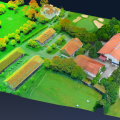
NASA's Lunar Reconnaissance Orbiter has been sending detailed images of the moon from its 50km orbit to scientists since June 2009. The images provide remarkably detailed views of the lunar surface, including features as small as 50cm.
Over the course of its mission, LRO is expected to generate 70-100 terabytes of data – which back on Earth is providing a challenge in terms of viewing and managing the data.
To help out, a team of scientists has created a crowdsourcing project called Moon Zoo. The project, headed by Oxford astrophysicist Chris Lintott, is aimed at amateur astronomers or anyone with an interest in the lunar landscape to help document the hundreds of thousands of lunar rocks, craters and other surface obstacles to better understand the moon’s history.
Participants help explore the surface of the moon by answering a series of questions about LRO images. The first step is to identify craters and then look for any surrounding boulders. Another section of the project is ‘Boulder Wars’, which involves comparing random images and deciding which has the most boulders.
The site contains tutorials to help participants in their lunar sleuthing and general information about the moon.
The project is also tracking non-geological obstacles. The images from the satellite are of high enough resolution that users can spot astronaut footprints left 40 years ago, according to the team. Participants are asked to search for debris from the Apollo missions, landing sites and other spacecraft hardware including Soviet Luna landers and rovers.
Moon Zoo’s Oxford-based software developer Afron Smith noted that in mid-March the team had collected close to 45 million classification clicks in the eight months the site has been running. Smith appears to be keeping busy designing a web stack that can cope with big traffic spikes while keeping an eye on hosting costs.
Interested in helping out? Visit www.moonzoo.org.







